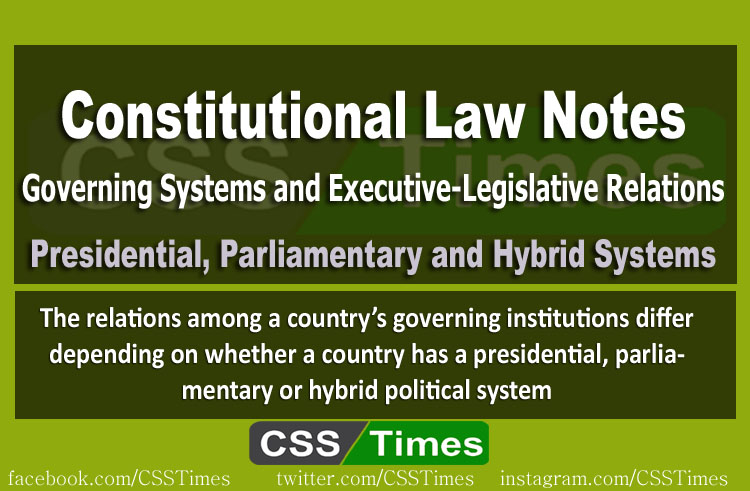Governing Systems and Executive-Legislative Relations
(Presidential, Parliamentary and Hybrid Systems)
The relations among a country’s governing institutions differ depending on whether a country has a presidential, parliamentary or hybrid political system. Although each country has its own variance on these political typologies, some conclusions have been drawn about the characteristics of each of these systems and their relationship to political conflict and executive and legislative power. These generalizations are useful for helping to determine characteristics of political systems of other nations three aspects of executive-legislative relations:
1) Separation of powers–the extent to which the powers of government are separated functionally between branches of government;
2) Removal from office–how each system defines the conditions for removing the executive and dissolving the government; and
3) The structure of legislative parties and leadership–the influence that the governing system has on the structures developed by parties in the legislature; degree of hierarchical control, internal discipline, and latitude for openness to representing local differences. Party discipline is needed to keep control of the executive, a need that varies among the three systems
Read Also: What is Constitutional Law? | CSS Constitutional Law Notes
Observers divide most constitutional systems into presidential (typified by the United States), parliamentary (typified by the United Kingdom), and semi-presidential (typified by France). In a presidential system, the chief executive (the president) is elected separately from the legis¬lature. In a parliamentary system, the chief executive (the prime minister) and sometimes other executive officials (cabinet ministers) are chosen by—and in some systems may be drawn from—the membership of the legislature. In parliamentary systems, the prime minister typically may be removed during office by a no-confidence vote in the legislature, while in a presidential system the presidents tenure in office does not depend on legislative support The most obvious conse¬quence of these differences in structure is that in a presidential system, the president is inde¬pendent of the legislature, and indeed may be from a different political party than the majority of the legislature. In a parliamentary system, on the other hand, whichever party or coalition of parties controls the legislature also controls the executive branch (sometimes called ‘the government’). Presidential systems thus exemplify a relatively high degree of separation between executive and legislative power, while parliamentary systems involve a greater fusion of executive and legislative authority. There are also hybrid systems, sometimes called ‘semi- presidential’ systems.
Read Also: The Concept of -Rule or Law | CSS Constitutional Law Notes
The United States (US) has a presidential system, as do countries it has influenced regionally, culturally or militarily, including Latin American countries and the Philippines. With the exception of the US, presidential systems in the past have often been associated with politically unstable and authoritarian regimes. Countries that have adopted a form of the parliamentarianism include the United Kingdom (UK), much of continental Europe, Israel, Japan, and many of the former British colonies in Africa and Asia, and most Caribbean countries. The French hybrid system (semi-presidential system) has provided a model for a number of countries and is highlighted throughout this section. Countries that have adopted the French Model include former French colonies in West Africa –such as Cote D’Ivoire, Gabon, Mali, and Senegal–and a few eastern European states, such as Poland and Bulgaria. Portugal also has a hybrid system, with similar elements as the French model. The Portuguese system has influenced former colonies like Mozambique and Angola.







